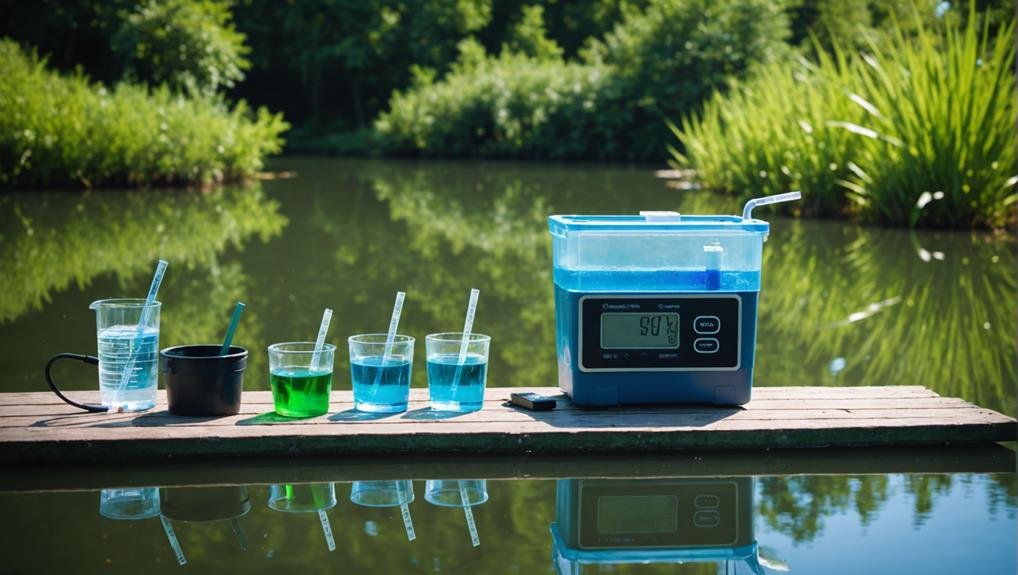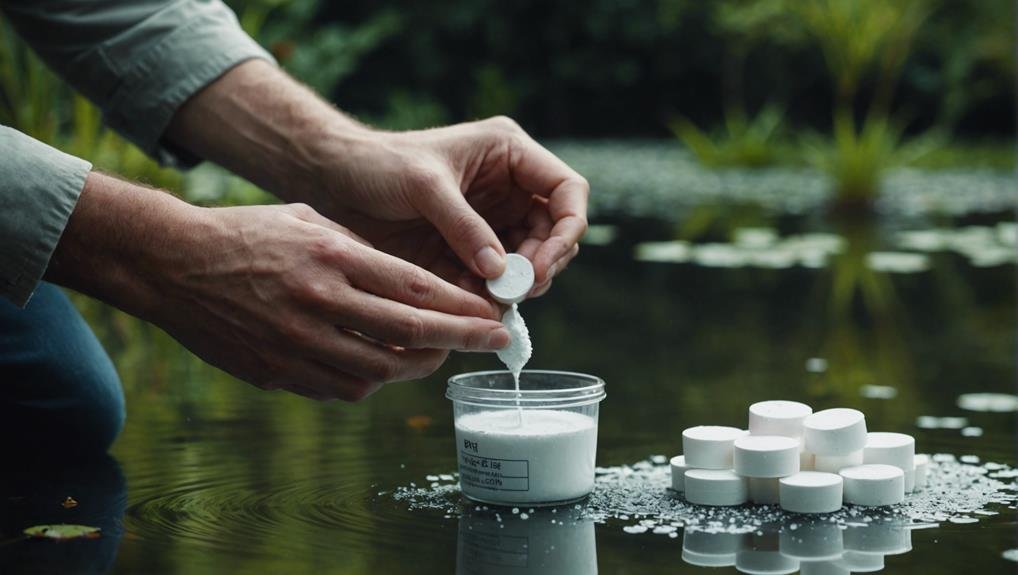Testing and maintaining pH levels in pond water is essential for a healthy aquatic environment. Start by collecting water samples from different areas of the pond. Use a liquid test kit or test strips to measure the pH, aiming for a range between 6.5 and 8.5.
Some of the links in this article may be affiliate links. If you make a purchase through these links, we may earn a small commission at no extra cost to you. Thank you.
Regular testing is crucial to catch any harmful fluctuations caused by factors like rain or decaying plants.
If the pH is too high, gradually lower it by incorporating peat moss. Conversely, if levels are too low, use baking soda to raise them.
Consistently monitoring and adjusting the pH ensures a stable and thriving ecosystem for both fish and plants. By staying proactive in maintaining balanced pH levels, you can create an optimal environment for aquatic life to thrive.
Remember, a healthy pond starts with balanced pH levels.
Understanding Ph Levels
Understanding pH levels in pond water is crucial for maintaining a healthy aquatic environment. pH measures the acidity or alkalinity of water on a scale from 0 to 14. For our ponds, we target a pH range of 6.5 to 8.5 to support fish and other aquatic life effectively. Deviations from this range can harm or even kill the pond's inhabitants.
Regular pH testing is essential to monitor water quality. By using a simple pH test kit, we can quickly assess our pond water's current condition. Consistent testing is important as pH levels can fluctuate due to factors like rainfall, plant decay, or the addition of new water.
Testing helps us determine if adjustments are needed to maintain a balanced environment. If we discover that the pH is too low (acidic) or too high (alkaline), we can take corrective measures.
Understanding how pH levels affect chemical solubility in pond water underscores the importance of regular testing and maintenance. By staying attentive, we can foster a thriving pond ecosystem.
Importance of Ph in Ponds
Maintaining the proper pH levels in our ponds is crucial because it directly impacts the health and well-being of the aquatic life and plants living in them. When the pH levels stray too high or too low, it can create a harmful environment for fish and other organisms, potentially leading to stress or even death. Most fish thrive within a specific pH range of 6.5 to 9.5, and any deviations from this range can result in stunted growth or fatalities.
Acidic water, especially, presents various risks. High acidity can disrupt the fish's ability to regulate their bodily functions and absorb essential nutrients. Moreover, it can negatively impact the overall water quality, making it less suitable for plants and beneficial bacteria that play a key role in maintaining a balanced ecosystem.
Regularly testing the pH levels is essential to promptly detect any changes. By collecting water samples from different areas within the pond, we can obtain a more accurate understanding of the overall pH balance. This consistent monitoring enables us to take necessary corrective measures, such as following liming recommendations, to uphold the ideal pH levels.
Ultimately, ensuring the right pH levels in our ponds guarantees a thriving and healthy aquatic environment for all inhabitants.
Tools for Testing Ph

Testing pond water pH accurately is crucial for maintaining a healthy ecosystem. Liquid test kits, such as the API Pond Master Test Kit, are a popular choice among pond owners for their reliability and precision. These kits offer straightforward usage and provide exact pH readings, ensuring the well-being of the pond.
Additionally, the API 5-in-1 Pond Test Strips are convenient for quick measurements of pH, general hardness (GH), and carbonate hardness (KH). While not as precise as liquid kits, test strips are valuable for monitoring multiple parameters simultaneously.
To effectively monitor pH levels, it's essential to use accurate testing tools and collect water samples from various areas of the pond. This practice helps in detecting any variations in pH levels across the entire pond. Regular testing and recording of pH levels over time enable tracking of changes and making necessary adjustments.
Steps to Test Ph
To check the pH of your pond water thoroughly, start by gathering water samples from various areas within the pond. This will give us a more accurate representation of the overall pH levels in the pond.
After collecting the water samples, mix them together in a clean container to create a well-blended sample for testing.
Next, use a reliable liquid test kit like the API Pond Master Test Kit to measure the pH levels accurately. These test kits come with all the necessary reagents and detailed instructions for easy and precise testing.
Once you've conducted the pH test, make sure to record the results for future reference. Keeping track of these readings over time will help us track any changes and make any necessary adjustments to the pond's water quality.
Raising Ph Levels

When adjusting the pH levels in our pond water, it's crucial to raise them gradually by adding alkaline substances like baking soda or crushed limestone. This gradual approach helps prevent sudden changes that could stress our aquatic life.
Following recommended dosages is key to avoid overcorrection, and it's essential to regularly test the pond pH after each adjustment.
Understanding how to manage pH levels and carbonate hardness involves considering the pond's buffering capacity. This capacity plays a vital role in maintaining a stable pH and preventing fluctuations.
Different substances serve specific purposes in this process: baking soda raises pH and increases carbonate hardness, crushed limestone gradually raises pH, and water changes help maintain a balanced pond pH.
Monitoring factors like water changes is also important, as they can impact overall stability. Seeking guidance from professionals can offer valuable insights on safely raising the pond's pH levels.
Making small adjustments and frequent testing are essential to ensure a healthy environment for pond inhabitants. Additionally, adding peat regularly can help manage pH levels, but it's advisable to consult an expert before making significant changes.
This careful and attentive approach is key to keeping the pond thriving and balanced.
Lowering Ph Levels
Maintaining the pH levels in our pond is crucial for the health of our aquatic environment. When the pH levels are too high, it's important to lower them gradually and safely.
Here are some effective methods to achieve lower pH levels in our pond. Firstly, consider adding peat moss or acidic substances like vinegar to the water in small, controlled amounts. These can help lower the pH without shocking the ecosystem.
Additionally, using pH reducer products designed for ponds can safely bring down pH levels without harming fish or plants. Regular water changes are also essential. By conducting frequent fresh water changes, the pond water is diluted, helping to maintain a stable pH balance while keeping carbonate hardness levels ideal for aquatic life.
If these methods don't produce the desired results, seeking advice from professionals is recommended. They can offer tailored solutions to ensure our pond remains a healthy and balanced environment for all its inhabitants.
Regular Ph Monitoring

Consistent monitoring of pH levels is crucial for maintaining a healthy pond ecosystem. By regularly checking the pH, we can detect any imbalances early on and ensure the well-being of aquatic life.
Various factors like fish waste, plant decay, and rainwater can lead to fluctuations in pH levels, which can be harmful to fish and plants if not addressed promptly.
To get a comprehensive view of the pond's pH, it's important to test water samples from different areas using a reliable test kit that includes a liquid test. Weekly testing is recommended, especially for established ponds where changes may not be immediately noticeable.
This routine monitoring helps prevent sudden shifts in pH levels that could result in harmful levels of Ammonia in the water, endangering the pond inhabitants.
Conclusion
Regularly testing and adjusting the pH levels of our pond is crucial for maintaining a healthy environment for aquatic life. Just like a gardener cares for their garden, we must use the right tools and follow a systematic approach to effectively manage pH levels. Consistent monitoring is essential, as maintaining proper pH balance is a continuous commitment to the well-being of our pond and its inhabitants.
Ensuring the pH levels in our pond are within the optimal range is vital for the overall health of the aquatic ecosystem. Without the correct pH balance, aquatic plants and animals can suffer, leading to potential issues like algae blooms and fish stress. By regularly testing the water and making necessary adjustments, we can create a stable and thriving environment for all living organisms in the pond.
One way to test and maintain pH levels in pond water is by using a pH testing kit, which provides accurate and easy-to-read results. These kits typically include test strips or liquid reagents that change color based on the pH level of the water. By following the instructions provided with the kit, we can quickly assess the pH of our pond water and take appropriate action if needed.
In addition to testing the pH levels, it's important to understand the factors that can influence pH in pond water. For example, factors like fish waste, decaying organic matter, and the use of certain chemicals can all impact the pH levels. By being aware of these factors and taking proactive steps to address them, we can maintain a stable pH balance in our pond and promote a healthy aquatic environment.
In conclusion, by regularly testing and adjusting the pH levels in our pond, we're proactively caring for the well-being of our aquatic ecosystem. Consistent monitoring, using the right tools, and understanding the factors that can influence pH levels are all essential components of maintaining a healthy pond environment. Remember, a well-balanced pH is the foundation for a thriving aquatic ecosystem.

